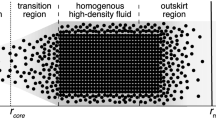Abstract
We describe some specific but reasonable conditions for the formation of superdense clumps (or minihalos) of dark matter. Such clumps can be produced by several mechanisms, most notably by spiky features in the spectrum of density perturbations. Being produced very early during the radiation-dominated epoch, these clumps evolve as isolated objects. They do not belong to hierarchical structures for a long time after production and are therefore not destroyed by tidal interactions during the formation of larger structures. If the clumps are constituted of superheavy dark matter particles, then the evolution of their central part can lead to a “gravithermal catastrophe,” increasing the central density and thus the annihilation signal. As a result, annihilations of superheavy neutralinos in dense clumps may lead to observable fluxes of annihilation products in the form of ultrahigh-energy particles.
Similar content being viewed by others
References
K. Griest and M. Kamionkowski, Phys. Rev. Lett., 64, 615–618 (1990); L. Hui, Phys. Rev. Lett., 86, 3467–3470 (2001).
V. Berezinsky, M. Kachelrieß, and A. Vilenkin, Phys. Rev. Lett., 79, 4302–4305 (1997); arXiv:astro-ph/9708217v1 (1997).
V. A. Kuzmin and V. A. Rubakov, Sov. J. Nucl. Phys., 61, 1028 (1998).
D. J.H. Chung, E. W. Kolb, and A. Riotto, Phys. Rev. D, 59, 023501 (1999); V. Kuzmin and I. Tkachev, JETP Lett., 68, 271–275 (1998); arXiv:hep-ph/9802304v1 (1998); D. H. Lyth and D. Roberts, Phys. Rev. D, 57, 7120–7129 (1998); arXiv:hep-ph/9609441v1 (1996).
V. Berezinsky, M. Kachelrié, and M. Aa. Solberg, Phys. Rev. D, 78, 123535 (2008); arXiv:0810.3012v2 [hep-ph] (2008).
P. Blasi, R. Dick, and E. W. Kolb, Astropart. Phys., 18, 57–66 (2002); arXiv:astro-ph/0105232v3 (2001).
E. W. Kolb and I. I. Tkachev, Phys. Rev. D, 50, 769–773 (1994); arXiv:astro-ph/9403011v1 (1994).
P. Scott and S. Sivertsson, Phys. Rev. Lett., 103, 211301 (2009); arXiv:0908.4082v5 [astro-ph.CO] (2009).
J. Yokoyama, Astron. Astrophys., 318, 673–679 (1997).
J. Garcia-Bellido, A. D. Linde, and D. Wands, Phys. Rev. D, 54, 6040–6058 (1996); arXiv:astro-ph/9605094v3 (1996).
C. Schmid, D. J. Schwarz, and P. Widerin, Phys. Rev. D, 59, 043517 (1999).
V. S. Berezinsky, A. V. Gurevich, and K. P. Zybin, Phys. Lett. B, 294, 221–228 (1992).
V. Berezinsky, A. Bottino, and G. Mignola, Phys. Lett. B, 391, 355–359 (1997).
R. Aloisio, V. Berezinsky, and M. Kachelrié, Phys. Rev. D, 69, 094023 (2004).
N. Seto and A. Cooray, Phys. Rev. D, 70, 063512 (2004); arXiv:astro-ph/0405216v1 (2004).
P. Tricarico, Class. Q. Grav., 26, 085003 (2009).
A. W. Adams and J. S. Bloom, “Direct detection of dark matter with space-based laser interferometers,” arXiv:astro-ph/0405266v2 (2004).
V. Berezinsky, V. Dokuchaev, Yu. Eroshenko, M. Kachelrié, and M. Aa. Solberg, Phys. Rev. D, 81, 103529 (2010); arXiv:1002.3444v2 [astro-ph.CO] (2010); Phys. Rev. D, 81, 103530 (2010); arXiv:1002.3445v2 [astroph. GA] (2010).
Author information
Authors and Affiliations
Corresponding author
Additional information
Prepared from an English manuscript submitted by the authors; for the Russian version, see Teoreticheskaya i Matematicheskaya Fizika, Vol. 170, No. 1, pp. 102–109, January, 2012.
Rights and permissions
About this article
Cite this article
Berezinsky, V.S., Dokuchaev, V.I., Eroshenko, Y.N. et al. Superdense dark matter clumps from superheavy particles. Theor Math Phys 170, 83–89 (2012). https://doi.org/10.1007/s11232-012-0008-7
Published:
Issue Date:
DOI: https://doi.org/10.1007/s11232-012-0008-7



